Assessment of Sowing Density Impact on Water Front Advancement and Infiltration in Furrow Irrigation
Abstract
:1. Introduction
2. Materials and Methods
2.1. Theoretical Background
Two-Point Method
2.2. Site Description, Experimental Design and Irrigation Management
2.3. Field Measurements
2.4. Statistical Analysis
3. Results and Discussion
3.1. Wetting Front Advancement
3.2. Infiltration
3.3. Furrow Irrigation System Performance
4. Conclusions
Author Contributions
Funding
Data Availability Statement
Acknowledgments
Conflicts of Interest
References
- Pereira, L.S.; Cordery, I.; Iacovides, I. Improved indicators of water use performance and productivity for sustainable water conservation and saving. Agric. Water Manag. 2012, 108, 39–51. [Google Scholar] [CrossRef]
- MARHP. Rapport National du Secteur de l’Eau; MARHP: Tunis, Tunisia, 2020; p. 282. [Google Scholar]
- Mazarei, R.; Soltani, M.A.; Ebrahimian, H.; Naseri, A.A. Temporal variability of infiltration and roughness coefficients and furrow irrigation performance under different inflow rates. Agric. Water Manag. 2021, 245, 106465. [Google Scholar] [CrossRef]
- Slatni, A.; Zayani, K.; Zairi, A.; Yacoubi, S.; Salvador, R.; Playan, E. Assessing alternate furrow strategies for potato at the Cherfech irrigation district of Tunisia. Biosyst. Eng. 2011, 108, 154–163. [Google Scholar] [CrossRef] [Green Version]
- Gillies, M.H.; Smith, R.J.; Raine, S.R. Accounting for temporal inflow variation in the inverse solution for infiltration in surface irrigation. Irrig. Sci. 2007, 25, 87. [Google Scholar] [CrossRef] [Green Version]
- Abdelmonem, M.A. Effects of water infiltration and storage in cultivated soil on surface irrigation. Agric. Water Manag. 2011, 98, 815–822. [Google Scholar]
- Clemmens, A.J.; Dedrick, A.R. Irrigation Techniques and Evaluations. In Advanced Series in Agricultural Sciences; Tanji, K.K., Yaron, B., Eds.; Springer: Berlin/Heidelberg, Germany, 1994; pp. 64–103. [Google Scholar]
- Zapata, N.; Playán, E.; Faci, J.M. Elevation and Infiltration on a Level Basin: II. Impact on Soil Water and Corn Yield. Irrig. Sci. 2000, 4, 165–173. [Google Scholar] [CrossRef] [Green Version]
- Playán, E.; Slatni, A.; Castillo, R.; Faci, J.M.A. Case Study for Irrigation Modernisation: II. Scenario Analysis. Agric. Water Manag. 2000, 42, 335–354. [Google Scholar] [CrossRef] [Green Version]
- Ghumman, A.R.; Iqbal, M.; Ahmad, S.; Hashmi, H.N. Experimental and numerical investigations for optimal emitter spacing in drip irrigation. Irrig. Drain. 2018, 67, 724–737. [Google Scholar] [CrossRef]
- Munish, K.; Parveen, S. Assessment of infiltration rate of soil using empirical and machine learning-based models. Irrig. Drain 2019, 68, 588–601. [Google Scholar]
- Karmeli, D.; Salazar, L.L.; Walker, W.R. Assessing the Spatial Variability of Irrigation Water Applications; EPA-600/2-78-041; U.S. Environmental Protection Agency, Robert S. Kerr Environmental Research Laboratory: Ada, OK, USA, 1978.
- Angelaki, A.; Sakellariou-Makrantonaki, M.; Tzimopoulos, C. Theoretical and experimental research of cumulative infiltration. Transp. Porous Media 2013, 100, 247–257. [Google Scholar] [CrossRef]
- Bahú Ben, L.H.; Xavier Peiter, M.; Dias Robaina, A.; Costenaro Parizi, A.R.; Da Silva, G.U. Influence of irrigation levels and plant density on “second-season” maize. Eng. Agric. Rev. Caatinga 2016, 29, 665–676. [Google Scholar] [CrossRef] [Green Version]
- El-Hendawy, S.E.; Abd El-Lattief, E.A.; Ahmed, M.S.; Schmidhalter, U. Irrigation rate and plant density effects on yield and water use efficiency of drip-irrigated corn. Agric. Water Manag. 2008, 95, 836–844. [Google Scholar] [CrossRef]
- Karimi, M.; Gomrokchi, A. Yield and water use efficiency of corn planted in one or two rows and applying furrow or drip tape irrigation systems in Ghazvin Province, Iran. Irrig. Drain. 2011, 60, 35–41. [Google Scholar] [CrossRef]
- Sani, B.M.; Oluwasemire, K.O.; Mohammed, H.I. Effect of irrigation and plant density on the growth, yield and water use efficiency of early maize in the Nigerian Savanna. J. Agric. Bio. Sci. 2008, 3, 33–40. [Google Scholar]
- Holzapfel, E.; Marino, M.A.; Chavez, J. Comparison and selection of furrow irrigation models. Agric. Water Manag. 1984, 9, 105–125. [Google Scholar] [CrossRef]
- Van den Boogaard, R.; Veneklaas, E.J.; Peacock, J.M.; Lambers, H. Yield and water use of wheat (Triticum aestivum) in a Mediterranean environment: Cultivar differences and sowing density effects. Plant Soil 1996, 181, 251–262. [Google Scholar] [CrossRef]
- Zhang, J.; Sui, X.; Li, B.; Su, B.; Li, J.; Zhou, D. An improved water-use efficiency for winter wheat grown under reduced irrigation. Field Crops Res. 1998, 59, 91–98. [Google Scholar] [CrossRef]
- Pandey, P.K.; Pandey, V. Estimation of infiltration rate from readily available soil properties (RASPs) in fallow cultivated land. Sustain. Water Resour. Manag. 2019, 5, 921–934. [Google Scholar] [CrossRef]
- Vand, A.S.; Sihag, P.; Singh, B.; Zand, M. Comparative evaluation of infiltration models. KSCE J. Civ. Eng. 2018, 22, 4173–4184. [Google Scholar] [CrossRef]
- Singh, B.; Sihag, P.; Singh, K. Comparison of infiltration models in NIT Kurukshetra campus. Appl. Water Sci. 2018, 8, 63. [Google Scholar] [CrossRef] [Green Version]
- Sterlkoff, T. BRDRFLW: A Mathematical Model for Border Irrigation; ARS, US, Department of Agriculture: Washington, DC, USA, 1985.
- Fekersillassie, D.; Einsenhauer, D.E. Feedback-controlled surge irrigation: I. Model development. Trans. ASAE 2000, 43, 1621–1630. [Google Scholar] [CrossRef]
- Slatni, A. Elaboration et évaluation des Scénarii D’amélioration des Performances de L’irrigation de Surface sur des Sols Lourds Gonflants. Ph.d. Thesis, National Agronomic Institute, Tunis, Tunisia, 2015. [Google Scholar]
- Slatni, A.; Yacoubi, S.; Zayani, K.; Playan, E. Evaluation des paramètres d’infiltration en irrigation à la raie sur trois types de sol [Evaluation of infiltration parameters in furrow irrigation on three types of soil]. Rev. Reg. Arid. 2017, 42, 97–211. [Google Scholar]
- Seyedzadeh, A.; Panahi, A.; Maroufpoor, E.; Singh, V.P. Developing a novel method for estimating parameters of Kostiakov–Lewis infiltration equation. Irrig. Sci. 2020, 38, 189–198. [Google Scholar] [CrossRef]
- Maghferati, H.R.; Chari, M.M.; Afrasia, P.; Delbari, M. Investigation of various volume–balance methods in surface irrigation. Arab. J. Geosci. 2021, 14, 241. [Google Scholar] [CrossRef]
- Panahi, M.; Khosravi, K.; Ahmad, A.; Panahi, S.; Heddam, S.; Melesse, A.M.; Omidvar, E.; Lee, C.W. Cumulative infiltration and infiltration rate prediction using optimized deep learning algorithms: A study in Western Iran. J. Hydrol. Reg. Stud. 2021, 35, 2214–5818. [Google Scholar] [CrossRef]
- Amer, A.M.; Amer, K.H. Surface Irrigation Management in Relation to Water Infiltration and Distribution in Soils. Soil Water Res. 2010, 5, 75–87. [Google Scholar] [CrossRef] [Green Version]
- Elliot, R.L.; Walker, W.R. Field evaluation of furrow infiltration and advance functions. Trans. ASAE 1982, 25, 396–400. [Google Scholar] [CrossRef]
- Walker, W.R.; Skogerboe, G.V. Surface Irrigation: Theory and Practice; Prentice-Hall, Inc.: Englewood Cliffs, NJ, USA, 1987; 386p. [Google Scholar]
- Ebrahimian, H.; Liaghat, A.; Ghanbarian-Alavijeh, B.; Abbasi, F. Evaluation of various quick methods for estimating furrow and border infiltration parameters. Irrig. Sci. 2010, 286, 479–488. [Google Scholar] [CrossRef]
- Ismail, S.M.; Depenweg, H. Simulation of continuous and surge flow irrigation under short held conditions. Irrig. Drain. 2005, 54, 217–230. [Google Scholar] [CrossRef]
- Upadhyaya, S.K.; Raghuwanshi, N.S. Semi-empirical infiltration equations for furrow irrigation systems. Irrig. Drain. 1999, 125, 173–178. [Google Scholar] [CrossRef]
- Bautista, E.; Clemmens, A.J.; Strelkoff, T.S.; Schlegel, J. Modern analysis of surface irrigation systems with WinSRFR. Agric. Water Manag. 2009, 96, 1146–1154. [Google Scholar] [CrossRef]
- Khatri, K.L.; Smith, R.J. Evaluation of methods for determining infiltration parameters from irrigation advance data. Irig. Drain. 2005, 54, 467–482. [Google Scholar] [CrossRef]
- Syar, R.; Khemira, H.; Bchini, H.; Bensalem, H.; Mosbah, M.; Nahdi, H. Utilisation des Composantes du Rendement Comme Outil D’évaluation de la Productivité chez le blé dur en Irrigué et en Pluvial; Annales de l’INRGREF. Issue Number 1; INRGREF: Tunis, Tunisia, 2007; pp. 58–67. ISSN 1737-0515. [Google Scholar]
- Rodrigues, P.N.; Pereira, L.S.; Machado, T.G. KCISA, A program to compute time averaged crop coefficients: Application to field grown vegetable crops. In Proceedings of the Third International Symposium on Irrigation of Horticultural Crops, Lleida, Spain, 8–11 June 2015; pp. 535–542. [Google Scholar]
- Zairi, A.; Slatni, A.; Mailhol, J.C.; Achour, H. Surface irrigation efficiency in cracking soils as influenced by water restriction. In Water and the Environment—Innovation Issues in Irrigation and Drainage; Pereira, L., Gowing, J., Eds.; CRC Press: Boca Raton, FL, USA, 1998; pp. 120–130. [Google Scholar]
- Walker, W.R. SIRMOD III: Surface Irrigation Simulation, Evaluation and Design; Software Engineering Division, Biological and Irrigation Engineering Department, Utah State University: Logan, UT, USA, 2003. [Google Scholar]
- Burt, C.M.; Clemmens, A.J.; Strelkoff, T.S.; Solomon, K.H.; Bliesner, R.D.; Hardy, L.A.; Howell, T.A.; Eisenhauer, D.E. Irrigation performance measures: Efficiency and uniformity. J. Irrig. Drain. Eng. ASCE 1997, 123, 423–442. [Google Scholar] [CrossRef] [Green Version]
- Nagaz, K.; EL Mokh, F.; Alva, A.K.; Masmoudi, M.M.; Ben Mechlia, N. Potato response to different irrigation regimes using saline water. Irrig. Drain. 2016, 65, 654–663. [Google Scholar] [CrossRef]
- Regüés, D.; Badía, D.; Echeverría, M.T.; Gispert, M.; Lana-Renault, N.; León, J.; Nadal-Romero, E.; Pardini, G.; Serrano-Muela, P. Analyzing the effect of land use and vegetation cover on soil infiltration in three contrasting environments in northeast Spain. Geog. Res. Lett. 2013, 43, 141–169. [Google Scholar]
- Meek, B.D.; Reche, E.R.; Carter, L.M.; DeTar, W.R.; Urie, A.L. Infiltration Rate of a Sandy Loam Soil: Effects of Traffic, Tillage, and Plant Roots. SSSAJ 1992, 56, 908–913. [Google Scholar] [CrossRef]
- Aggarwal, P.K.; Singh, A.K.; Chaturvedi, G.S.; Sinha, S.K. Performance of wheat and triticale cultivars in a variable soil—Water environment. Field Crops Res. 1986, 13, 301–315. [Google Scholar] [CrossRef]
- Balwinder-Singh, G.D.S.; Humphreys, E.; Eberbach, P.L.; Katupitiya, A.; Kukal, S.S. Growth, yield and water productivity of zero-till wheat as affected by rice straw mulch and irrigation schedule. Field Crops Res. 2011, 121, 209–225. [Google Scholar] [CrossRef]
- Ali, M.H.; Hoque, M.R.; Hassan, A.A.; Khair, A. Effects of deficit irrigation on yield, water productivity and economic returns of wheat. Agric. Water Manag. 2007, 92, 151–161. [Google Scholar] [CrossRef]
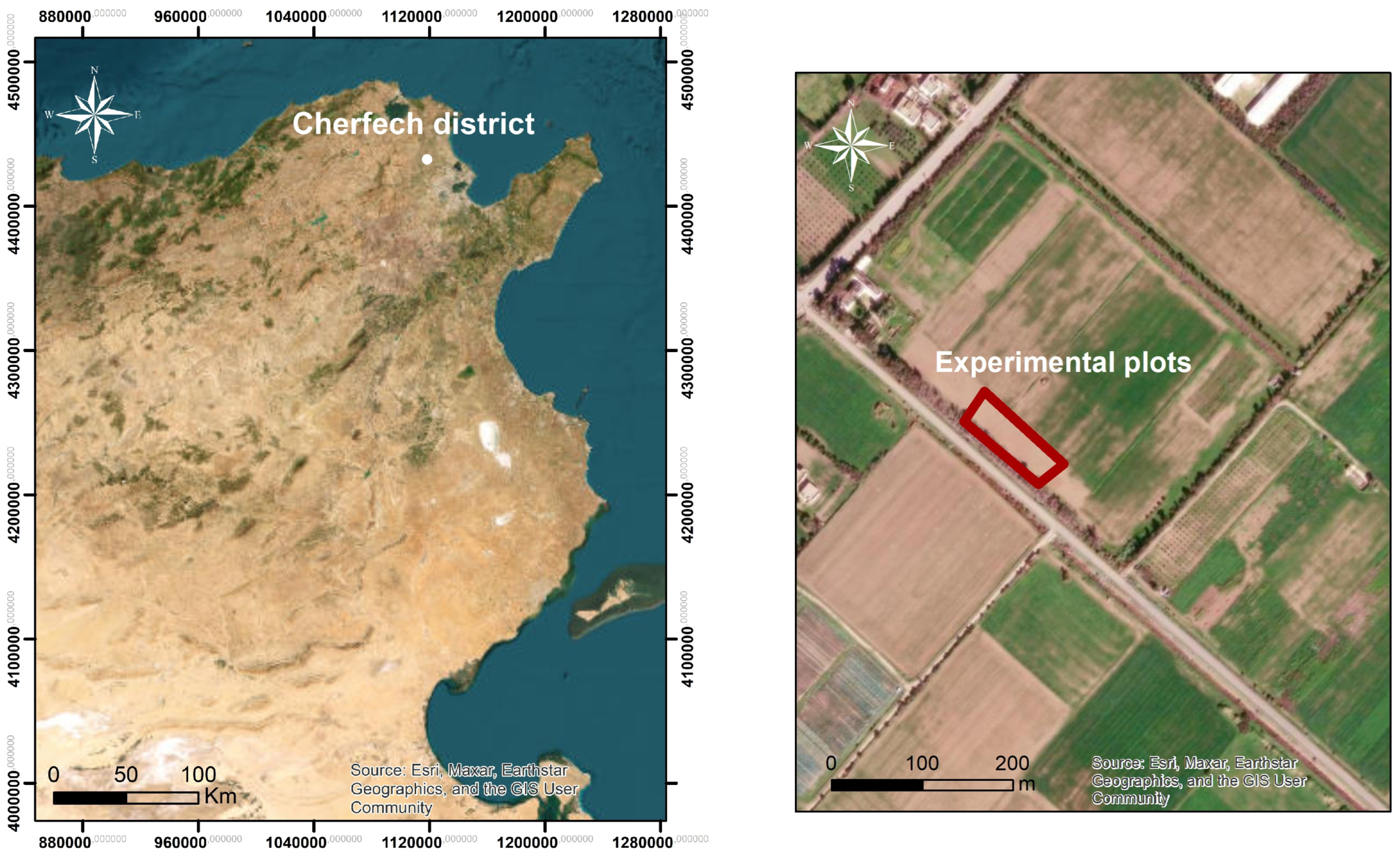
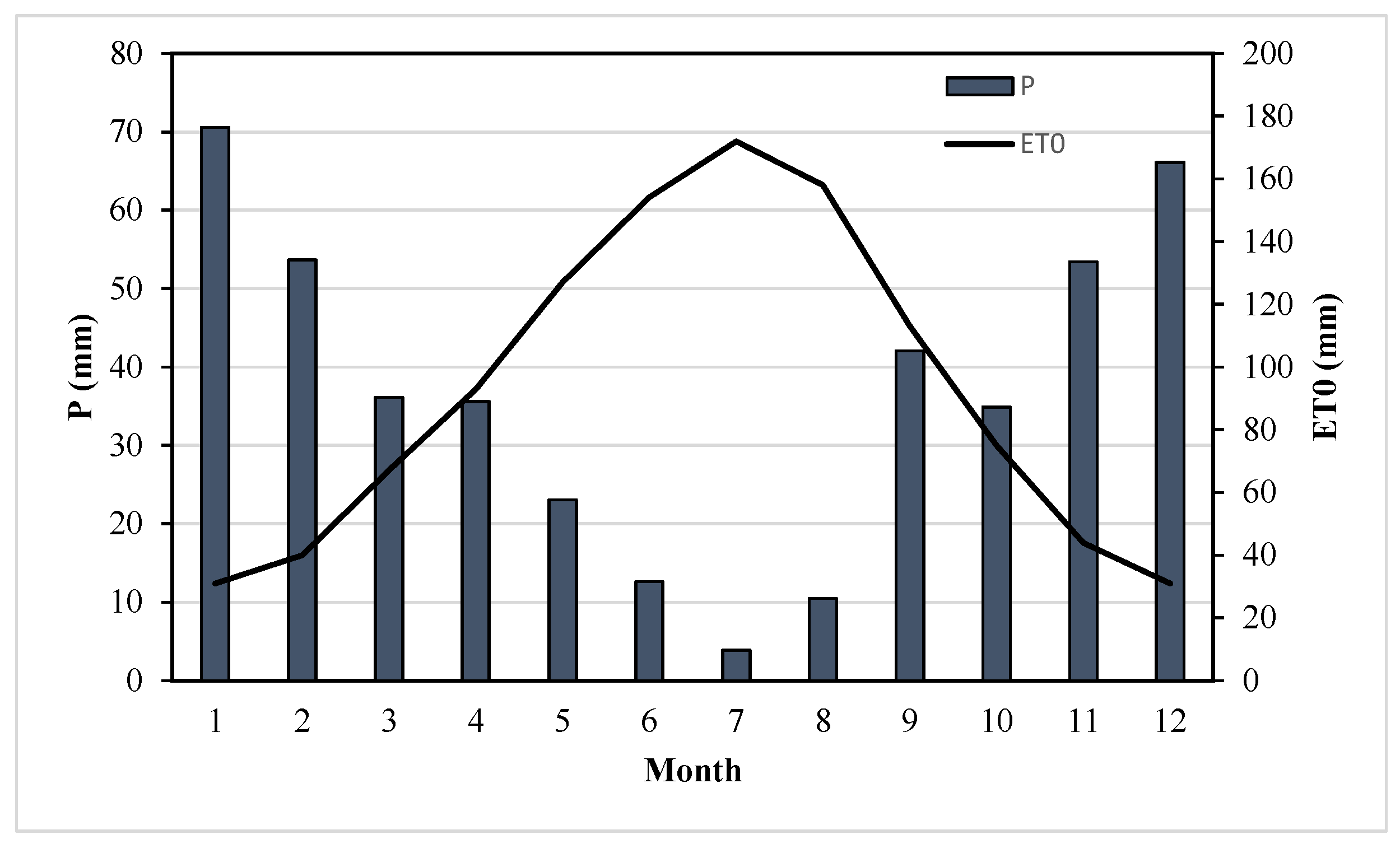
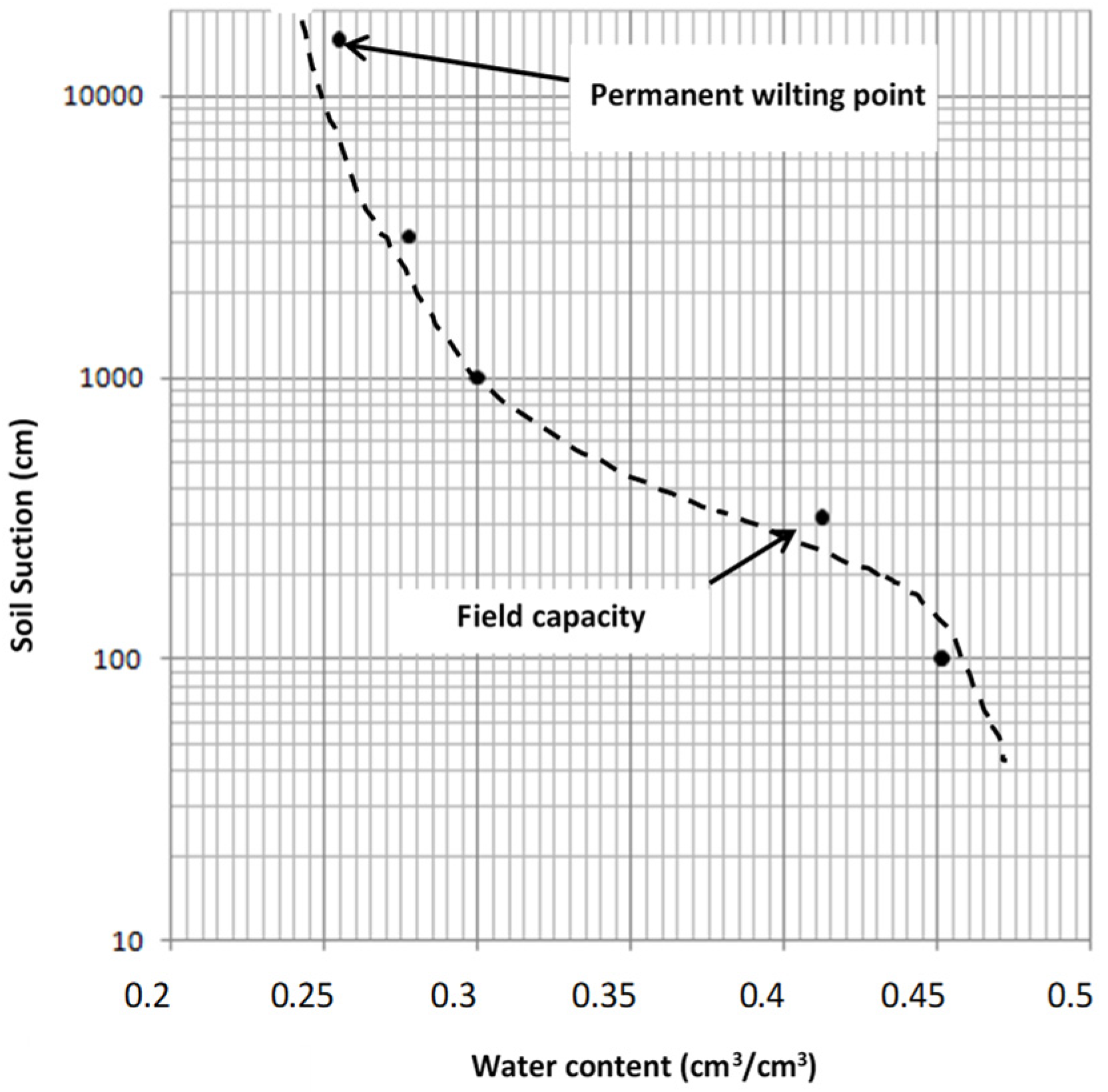
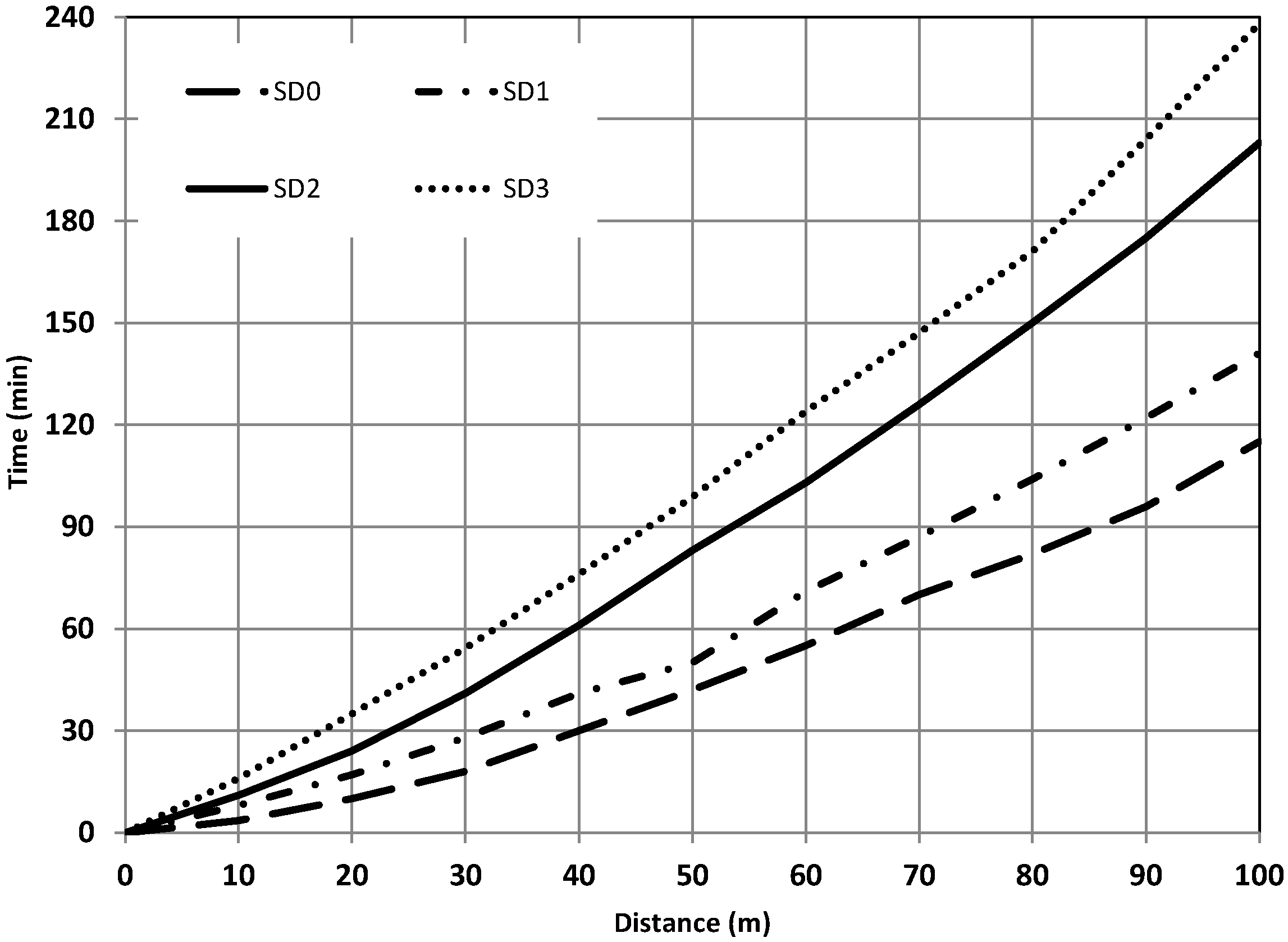
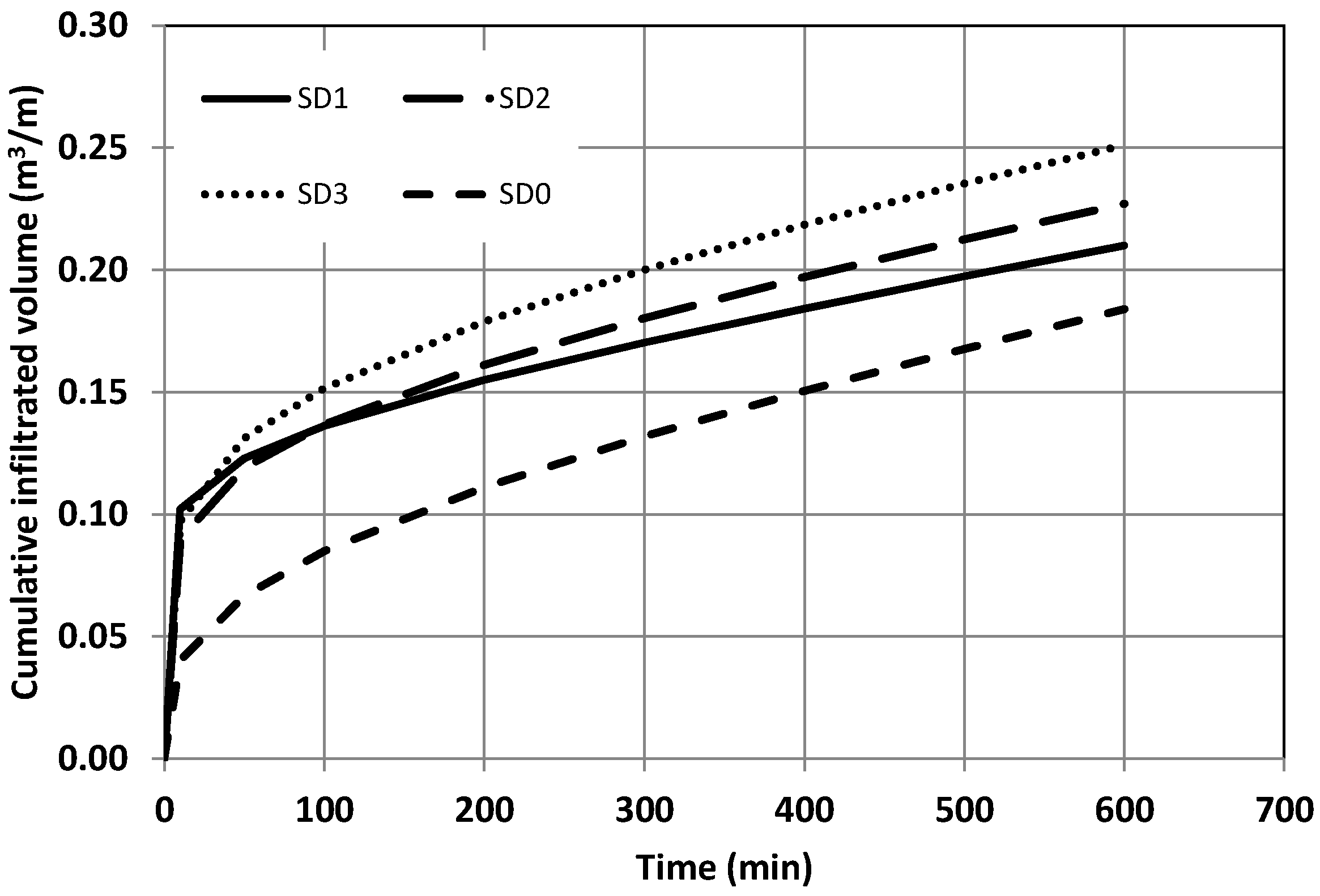
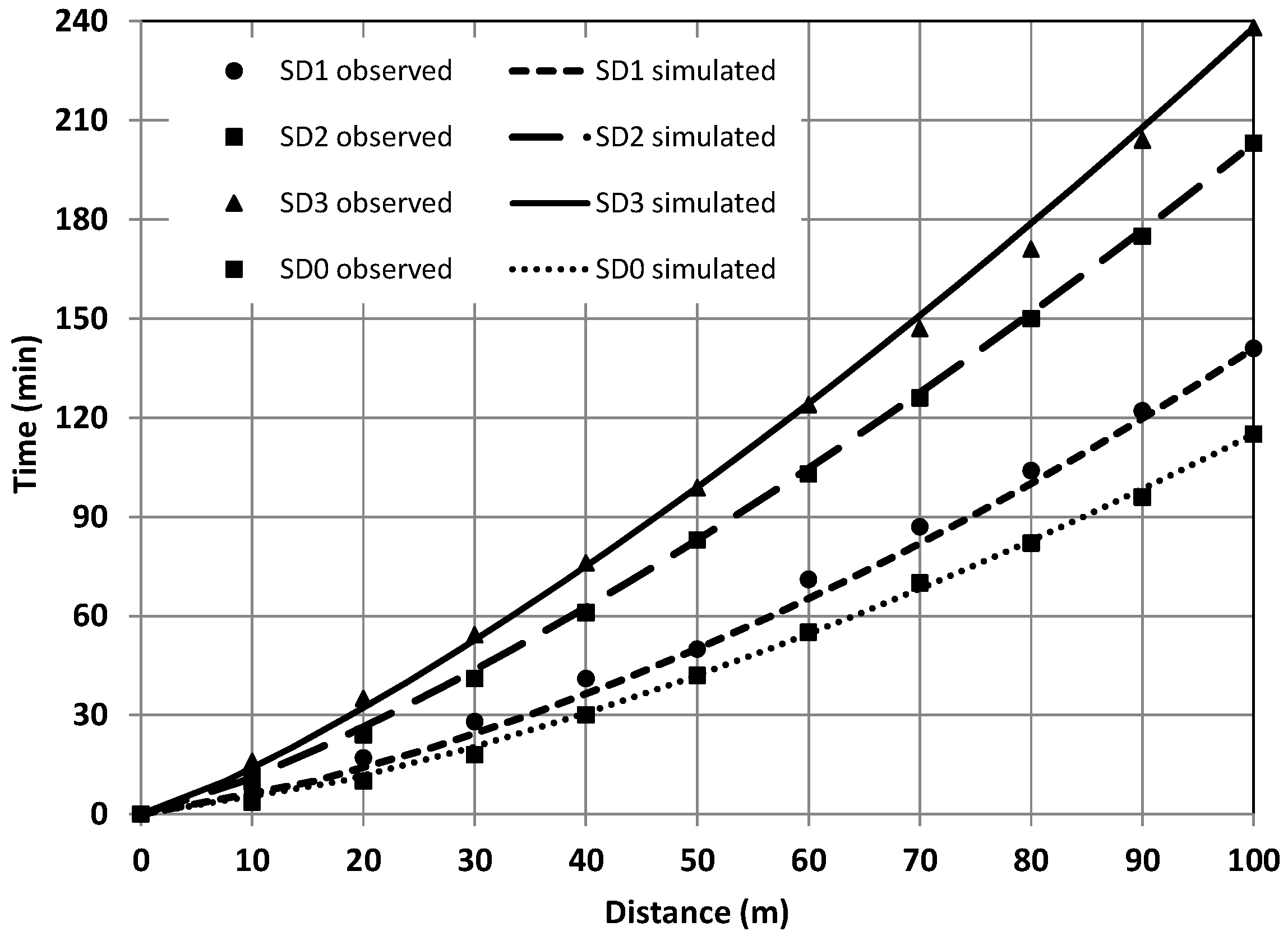
| Month | J | F | M | A | M | J | J | A | S | O | N | D |
|---|---|---|---|---|---|---|---|---|---|---|---|---|
| Tmin (°C) | 6.1 | 5.9 | 7.0 | 8.5 | 12.1 | 16.1 | 17.7 | 19.0 | 17.3 | 13.9 | 9.8 | 6.9 |
| Tmax (°C) | 15.7 | 16.4 | 18.4 | 21.3 | 26.1 | 30.4 | 33.5 | 33.8 | 30.6 | 26.3 | 20.7 | 17.0 |
| WS (m/s) | 0.98 | 1.04 | 1.19 | 1.31 | 1.45 | 1.51 | 1.46 | 1.32 | 1.16 | 0.95 | 0.86 | 0.89 |
| Depth (cm) | θfc (%) | θpwp (%) |
|---|---|---|
| 0–20 | 42.6 | 26.7 |
| 20–40 | 41.9 | 26.0 |
| 40–60 | 42.3 | 24.5 |
| 60–80 | 44.8 | 26.2 |
| 80–100 | 38.6 | 26.2 |
| SD0 | SD1 | SD2 | SD3 | |
|---|---|---|---|---|
| RSME | 1.04 | 3.29 | 1.78 | 3.31 |
| RSR | 0.004 | 0.010 | 0.008 | 0.016 |
| R2 | 0.99 | 0.98 | 0.99 | 0.99 |
| CRM | −0.011 | 0.043 | −0.003 | −0.007 |
| SD0 | SD1 | SD2 | SD3 | |
|---|---|---|---|---|
| Ea (%) | 75 | 80 | 82 | 75 |
| DU (%) | 85 | 90 | 93 | 95 |
| Irrigation depth (mm) | 62 | 74 | 108 | 123 |
| Total irrigation (mm) | 250 | 295 | 430 | 490 |
| Yield (t ha−1) | 3.5 | 4.6 | 4.9 | |
| WPirrig (kg m−3) | 1.18 | 1.07 | 1 |
Disclaimer/Publisher’s Note: The statements, opinions and data contained in all publications are solely those of the individual author(s) and contributor(s) and not of MDPI and/or the editor(s). MDPI and/or the editor(s) disclaim responsibility for any injury to people or property resulting from any ideas, methods, instructions or products referred to in the content. |
© 2023 by the authors. Licensee MDPI, Basel, Switzerland. This article is an open access article distributed under the terms and conditions of the Creative Commons Attribution (CC BY) license (https://creativecommons.org/licenses/by/4.0/).
Share and Cite
Slatni, A.; Yacoubi, S.; Hermassi, T.; Latrech, B.; Zayani, K. Assessment of Sowing Density Impact on Water Front Advancement and Infiltration in Furrow Irrigation. Agronomy 2023, 13, 2080. https://doi.org/10.3390/agronomy13082080
Slatni A, Yacoubi S, Hermassi T, Latrech B, Zayani K. Assessment of Sowing Density Impact on Water Front Advancement and Infiltration in Furrow Irrigation. Agronomy. 2023; 13(8):2080. https://doi.org/10.3390/agronomy13082080
Chicago/Turabian StyleSlatni, Adel, Samir Yacoubi, Taoufik Hermassi, Basma Latrech, and Khemaies Zayani. 2023. "Assessment of Sowing Density Impact on Water Front Advancement and Infiltration in Furrow Irrigation" Agronomy 13, no. 8: 2080. https://doi.org/10.3390/agronomy13082080
APA StyleSlatni, A., Yacoubi, S., Hermassi, T., Latrech, B., & Zayani, K. (2023). Assessment of Sowing Density Impact on Water Front Advancement and Infiltration in Furrow Irrigation. Agronomy, 13(8), 2080. https://doi.org/10.3390/agronomy13082080






